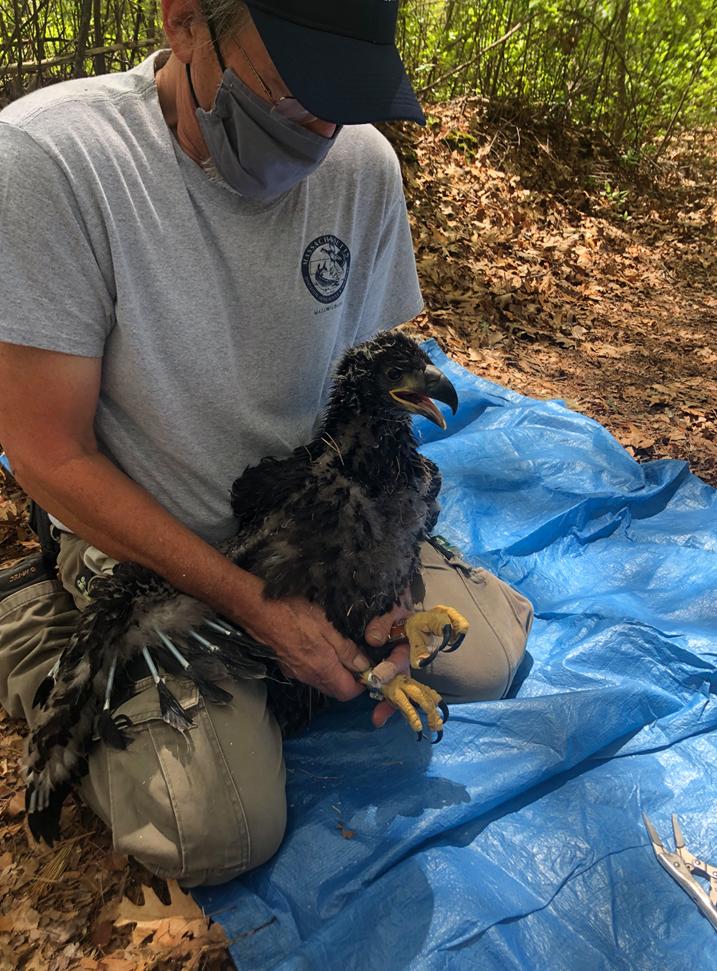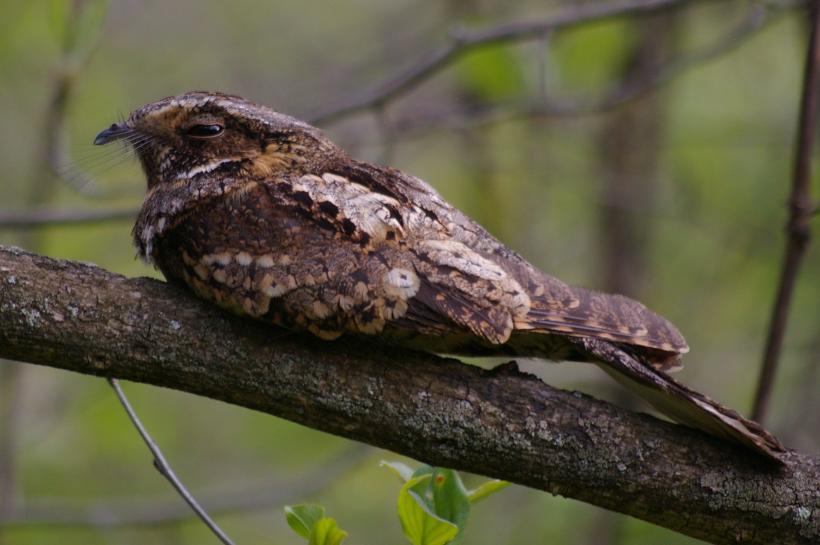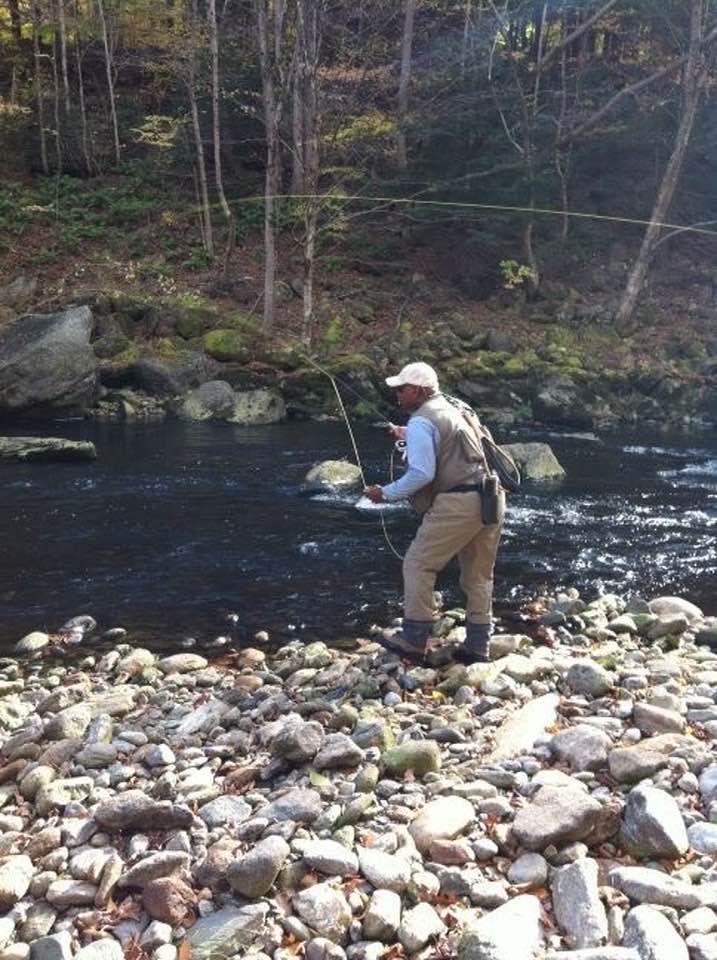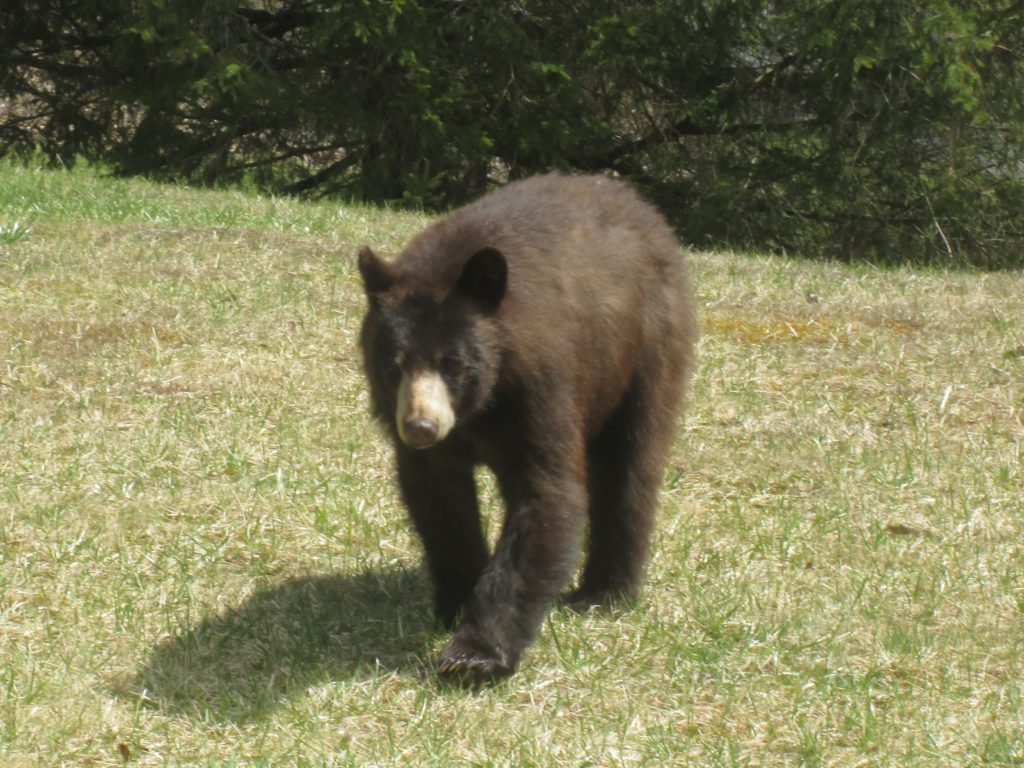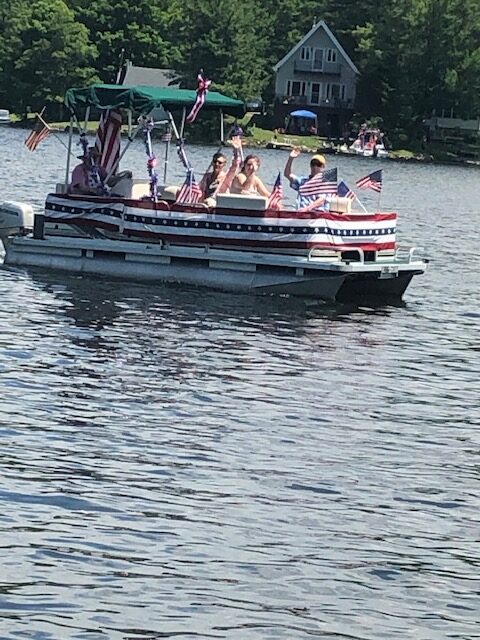
Besides catching a few nice fish, Ashmere Lake anglers (in Hinsdale) had an added pleasure on the afternoon of July 4. They got to see a parade from their boats. I’ll bet you thought there were no parades around here on that day this year, but there was…. a boat parade.
It’s a tradition that began years ago and is still going strong. Under the direction of the Skyview Grove Lake Association, boat owners, especially pontoon boat owners, decorate their boats with flags and bunting, form up in a designated location and sail into each area of the northern basin of Ashmere Lake.(They can’t cross Rte. 143 to the south basin due to the size of the culvert). All of the 20 or so boats tooted their horns and some of them provided patriotic music. The weather was perfect and all of the passengers waived to the cottage owners and visitors who were out on docks and lawns and who eagerly awaited their sail-by. Even though the ruckus may have put the fish down, the anglers received and returned enthusiastic waves…..and a few put down their fishing rods and took time to honor our flag..
After all our nation has had to endure lately it was a welcome respite. While practicing social distancing, people were smiling and waving. There were many shouts of “Happy 4th”
Unfortunately, not all people choose to share the joy of Independence Day. Although the Declaration of Independence holds certain truths to be self-evident, among them that all men are created equal, let’s face it, not all people in our country are treated equally. We must correct that, and soon.
Who doesn’t love the words of that old patriotic song “God Bless America. “Stand beside her and guide her through the night with the light from above.” There is another song, a country and western one, which carries another powerful message, too. Entitled God Bless America Again, it goes like this: “God bless America again, you see all the troubles that she’s in. Wash her pretty face dry her eyes and then, God bless America again.
Google it to hear the rest of it sung by country singers Loretta Lynn, Conway Twitty or Bobby Bare.
Antlerless deer permit application due by next week
If you want to hunt antlerless deer in 2020, you must apply for an antlerless deer permit by this Thursday, July 16. You can check back after August 1 to find out if you have been awarded the ability to purchase the permit. Hunters can apply online using MassFishHunt on a computer or smartphone. You need a valid hunting or sporting license to apply for an antlerless deer permit. There is no fee to apply; a $5 fee is charged only if you are awarded a permit during the instant award period.
The instant award period begins on August 1 at 8:00 am and ends on December 31. Your odds of being awarded a permit are the same regardless of when you check your permit status. You can check the status of your permit through MassFishHunt.
Sale of surplus antlerless deer permits by Wildlife Management Zone will be staggered over the following days in September and October:
- Zone 11: Tuesday, September 29 at 9 a.m.
- Zone 10: Wednesday, September 30 at 9 a.m.
- Zone 9 (if available), 13, and 14: Thursday, October 1 at 9 a.m.
Surplus Permits are first-come, first-served. Surplus permits must be purchased within 15 minutes after being placed in your shopping cart. The MassFishHunt online licensing system only allows 1 session per customer, so do not log in on multiple devices or you may be kicked out of the system and need to start over.
You may purchase only one Zone 11, one Zone 10, or one Zone 9 permit per day; up to four permits per day may be purchased for Zones 13 and 14.
2020–2021 Migratory game bird hunting
The MA Fisheries and Wildlife Board recently approved season dates, bag limits, and other regulations for the 2020–2021 migratory game bird hunting seasons. You can view the 2020-2021 Massachusetts migratory game bird seasons dates and bag limits by clicking onto the MassWildlife website https://www.mass.gov/doc/2020-2021-migratory-game-bird-regulations/download. There will be more in this column as the hunting dates get closer. I do want to bring to your attention that new this year, there will be two special waterfowl hunt days for veterans.
Two statewide Veteran Waterfowl Hunt season dates (October 3, 2020 and January 30, 2021) are open for waterfowl hunting by veterans and current members of the Armed Forces on active duty, including members of the National Guard and Reserve on active duty (other than for training). The term “veteran,” is defined, per section 101 of title 38, United States Code, as a person who served in the active military, naval, or air service, and who was discharged or released under conditions other than dishonorable. Proof of eligibility is required and must be carried on person while hunting.
All waterfowl hunting regulations and bag limits apply. Waterfowl that may be hunted include ducks, coot, mergansers, sea ducks, brant, Canada, Snow and Blue Geese.
COVID-19 and the 2020 Sportfishing Awards Program
There has been a change in the MA Freshwater Sportfishing Awards Program this year. The Catch and Keep category, both Youth and Adult categories, has been suspended until further notice. Fish in the Catch and Keep category must be weighed on a certified scale to be eligible for the program. Since most public certified scale locations are no longer open due to the COVID-19 State of Emergency, MassWildlife is temporarily halting this portion of the program. Consequently, fish caught or submitted on or after March 16 will not be accepted. Submissions are still being accepted for Catch and Release category since the only requirements for entry are a picture of the fish with a measuring device.
MassWildlife says, “Don’t let this disruption keep you off the water! Fishing is still open and it’s a great way to relax outdoors while social distancing. Remember to remain 6 feet away from other people while participating in outdoor activities”.
We are in a drought
The MA Secretary of Energy and Environmental Affairs Kathleen Theoharides declared a Level 2-Significant Drought in the Western, Connecticut River Valley, Central and Northeast EEA Drought Regions, on June 24, 2020, based on hydrologic conditions in May and June, 2020. The Level 2- Significant Drought is more severe than the Level 1 – Mild Drought (formerly Advisory Drought). Based on the Secretary’s determination, a “drought” exists for purposes of Riverfront Area and Pond observations.
Wetlands Protection Act Regulations: For any Notices of Intent (NOI) or Notices of Resource Area Delineation (NRAD) filed on or after June 24, 2020, observation of rivers that have ceased flowing made on May 1, 2020 and thereafter, may not be used to prove a perennial river is an intermittent stream with no Riverfront Area since drought conditions.
Drought for purposes of the Riverfront Area and Pond Observations will remain in effect until such time as the Secretary issues a written statement declaring that water resource conditions have returned to normal, ending the drought. The written statement declaring the drought over will be posted at the Massachusetts Executive Office of Energy and Environmental Affairs web site.
Fish & Wildlife Board Meeting
The July MA Fish & Wildlife Board meeting is scheduled for July 14 at 1:00 pm. The public is welcome to log in through Zoom and listen. The link is https://www.mass.gov/service-details/fisheries-and-wildlife-board-meetings. The presentation on trout this coming month should be very informative. Many thanks to Western District Board member Steve Sears for the heads-up.








